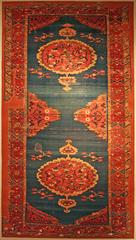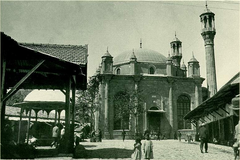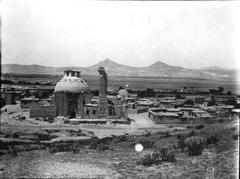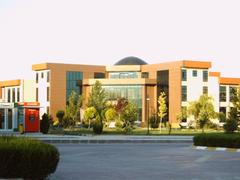Mevlana Museum Visiting Hours, Tickets, and Historical Significance in Konya
Date: 14/06/2025
Introduction: The Heart of Sufi Heritage in Konya
The Mevlâna Museum, located in the center of Konya, Turkey, stands as a profound testament to the spiritual and cultural legacy of Jalal ad-Din Muhammad Rumi, the 13th-century Persian poet and Sufi mystic. Known widely as Mevlâna, Rumi’s messages of love, unity, and spiritual enlightenment have transcended centuries, making the museum a focal point for pilgrims, history enthusiasts, and travelers seeking a unique cultural experience. Originating from a rose garden gifted by Sultan ‘Ala’ al-Din Kayqubad, the site evolved from a mausoleum to a dervish lodge and, ultimately, to a museum housing sacred relics, manuscripts, and the iconic turquoise dome that defines Konya’s skyline. The Mevlâna Museum is also renowned for hosting the annual Seb-i Arus festival, where the whirling dervishes perform their symbolic Sema ritual.
This guide offers detailed insights into the museum’s history, layout, key attractions, ticketing information, visiting hours, accessibility, travel tips, and nearby sites—ensuring an enriching visit to one of Turkey’s most significant spiritual landmarks. For further details on events and practical information, reputable sources include Thrillophilia, Invest in Konya, and Holidify.
Table of Contents
- Historical Background: Rumi and the Mevlâna Museum
- Museum Layout and Key Attractions
- Cultural and Religious Significance
- Visitor Information: Hours, Tickets, and Accessibility
- Visitor Experience and Insider Tips
- Nearby Attractions and Konya Highlights
- Frequently Asked Questions (FAQ)
- Summary and Practical Tips
- Sources and Further Reading
Historical Background: Rumi and the Mevlâna Museum
The Mevlâna Museum’s roots trace back to a 13th-century rose garden, gifted to Rumi’s family upon their arrival in Konya. Rumi, born in 1207 in Balkh, rose to prominence in the Seljuk Sultanate, where his teachings—profoundly influenced by his friendship with Shams-e Tabrizi—formed the foundation for the Mevlevi Order. Following Rumi’s death in 1273, his tomb became a revered pilgrimage site, and the complex expanded over centuries to include Seljuk and Ottoman architectural features. Today, the museum safeguards invaluable manuscripts, relics, and the enduring spiritual heritage of the Mevlevi Sufi tradition (Eskapas, Invest in Konya).
Museum Layout and Key Attractions
Entrance and Gardens
Visitors enter through an ornate gate into tranquil gardens, dotted with roses, fountains, and ancient tombstones. The serene setting transitions guests from city bustle to spiritual reflection (Eskapas).
Courtyard and Ablutions Fountain
The Dervişan Kapısı leads to a spacious courtyard centered on a marble ablutions fountain from 1512, historically used for ritual cleansing (Lonely Planet).
The Mausoleum of Rumi
Crowned with the iconic green dome, the mausoleum houses Rumi’s sarcophagus, family tombs, and graves of early dervishes. The chamber’s spiritual ambiance is enhanced by rosewater scents and soft prayers. Visitors must wear provided shoe covers and observe modest dress (women should cover their heads) (Lonely Planet).
Semahane (Whirling Dervish Hall)
Once the venue for sema rituals, the Semahane now exhibits musical instruments, dervish costumes, illuminated manuscripts (including Rumi’s Mesnevi), and audiovisual presentations on Sufi traditions (Eskapas).
Dervish Cells and Matbah (Kitchen)
The northern and western courtyard sides feature dervish living quarters, now ethnographic exhibits with artifacts, clothing, and devotional items. The reconstructed matbah displays mannequins depicting communal dervish life and a practice board for the whirling dance (Lonely Planet).
Library and Artifacts
The museum’s library contains over 1,700 manuscripts and rare Qur’ans, with select works on display. Artifacts include Rumi’s coffin cover, the ceremonial April Bowl, Ottoman carpets, and historic metalwork (WhichMuseum).
Cultural and Religious Significance
Rumi’s Tomb: A Pilgrimage Destination
The heart of the museum is Rumi’s tomb, enveloped in velvet and Islamic calligraphy, drawing millions of pilgrims annually. The inscription, “Whoever enters incomplete, will leave complete,” inspires reflection (Thrillophilia, Invest in Konya).
The Mevlevi Order and Whirling Dervishes
The museum preserves the traditions of the Mevlevi Order, with the Sema Hall hosting whirling dervish ceremonies symbolizing the soul’s journey to divine unity. The Seb-i Arus festival each December commemorates Rumi’s passing and attracts thousands (Visit Turkey).
Manuscripts and Sufi Heritage
Rare manuscripts, including Rumi’s Masnavi and musical instruments, are showcased, affirming the museum’s role as a hub for Sufi scholarship (Thrillophilia).
Symbolism and Architecture
The museum’s architecture is rich in symbolism, from the Gate of the Dervishes to the circular Sema Hall, each element enhancing the visitor’s spiritual journey (Eskapas, Visit Turkey).
Universal Appeal and Contemporary Role
The Mevlâna Museum’s message of love and unity resonates globally, making it a center for interfaith dialogue and a pillar of contemporary Turkish culture (Invest in Konya).
Visitor Information: Hours, Tickets, and Accessibility
Visiting Hours
- Standard Hours: Open daily, typically from 9:00 AM to 5:00 PM (Holidify).
- Extended Hours: During peak seasons, hours may extend to 6:30 PM. Always check the official website or local tourism boards for current information.
- Best Times: Early mornings and late afternoons offer a quieter experience.
Tickets and Admission
- Standard Ticket: TRY 25 (~$0.80 USD) as of June 2025.
- Discounts: Free for children under 8; reduced rates for students, seniors, and groups.
- Purchase: Tickets available at the entrance or online. Advance purchase recommended during festivals (WhichMuseum).
Accessibility
- Facilities: Restrooms, gift shop, information desks.
- Mobility: Wheelchair accessible in most areas; some historic sections have steps or uneven floors.
- Assistance: Staff are available to help visitors with mobility needs.
Photography and Dress Code
- Photography: Permitted in most areas; restricted in the mausoleum and during ceremonies.
- Attire: Modest dress required; women should bring a scarf (WaysoftheWorldBlog).
Guided Tours
- Languages: Multiple languages available.
- Audio Guides: Offered for a fee.
- Booking: Onsite or through reputable travel agencies.
Visitor Experience and Insider Tips
- Atmosphere: The museum offers a serene, contemplative environment, enriched by rose gardens and historical displays.
- Crowds: Mornings are less crowded; afternoons and festival periods can be busy.
- Duration: Most visits last 1–2 hours; allow extra time for guided tours or special events.
- Travel Tips:
- Wear comfortable shoes due to walking and standing.
- Observe silence and mindfulness in sacred areas.
- Check weather and dress accordingly (Konya has hot summers and cold winters).
- Souvenirs such as Rumi-inspired gifts and books are available in the museum shop.
Nearby Attractions and Konya Highlights
The Mevlâna Museum’s central location provides easy access to other key Konya attractions:
- Alaeddin Mosque: A Seljuk-era mosque on Alaeddin Hill.
- Ince Minaret Medrese: Known for its intricate stone carvings.
- Aziziye Mosque: Features distinctive Ottoman architecture.
- Karatay Museum: Exhibits Seljuk tiles and ceramics (Trip.com).
Local restaurants and cafes nearby serve traditional Turkish cuisine. Accommodation options range from budget guesthouses to upscale hotels, many within walking distance.
Frequently Asked Questions (FAQ)
Q: What are the Mevlâna Museum’s visiting hours?
A: Open daily from 9:00 AM to 5:00 PM (sometimes later during peak seasons or festivals).
Q: How much are tickets?
A: Standard admission is TRY 25 (~$0.80 USD); discounts available for children, students, and seniors.
Q: Is photography allowed?
A: Yes, except in the mausoleum and during ceremonies.
Q: Are guided tours available?
A: Yes, in multiple languages; audio guides also offered.
Q: Is the museum accessible for those with mobility challenges?
A: Most areas are accessible; some historic sections may be difficult.
Q: Can I see the Whirling Dervish ceremony at the museum?
A: Ceremonies are held at the adjacent Mevlâna Cultural Center, with tickets sold separately—especially during the annual Seb-i Arus festival.
Summary and Practical Tips
The Mevlâna Museum is a unique convergence of history, spirituality, and art, offering visitors an immersive experience into the world of Rumi and the Mevlevi Sufi Order. With affordable ticket prices, accessible facilities, and a central location, the museum is an essential stop for anyone exploring Turkish culture. For the best visit, plan ahead, check official resources for updates, and consider a guided tour. Modest dress and respectful conduct are expected.
Stay informed about current events, visiting hours, and travel advisories via official museum sources and trusted travel platforms:
For interactive maps, guided tours, and real-time updates, download the Audiala app and explore related posts on Konya’s cultural attractions.
Sources and Further Reading
- Thrillophilia – Mevlâna Museum
- Invest in Konya – Culture and Tourism
- Eskapas – Mevlâna Museum
- Holidify – Mevlâna Museum
- WhichMuseum – Mevlâna Museum Tickets and Prices
- Visit Turkey – Konya



